Where to dig in?
You’ll need the best gardening shoes for each season and task to maximize comfort and protection. Choose waterproof rubber boots with ankle support for spring’s muddy conditions, breathable mesh clogs or lightweight shoes for summer heat, and insulated, slip-resistant boots for fall and winter work. Steel-reinforced options handle heavy-duty tasks, while flexible designs work best for light maintenance. Memory foam insoles, cushioned footbeds, and proper materials guarantee all-day comfort across varied terrain and weather conditions, with expert recommendations available below.
Essential Materials That Make Great Gardening Footwear
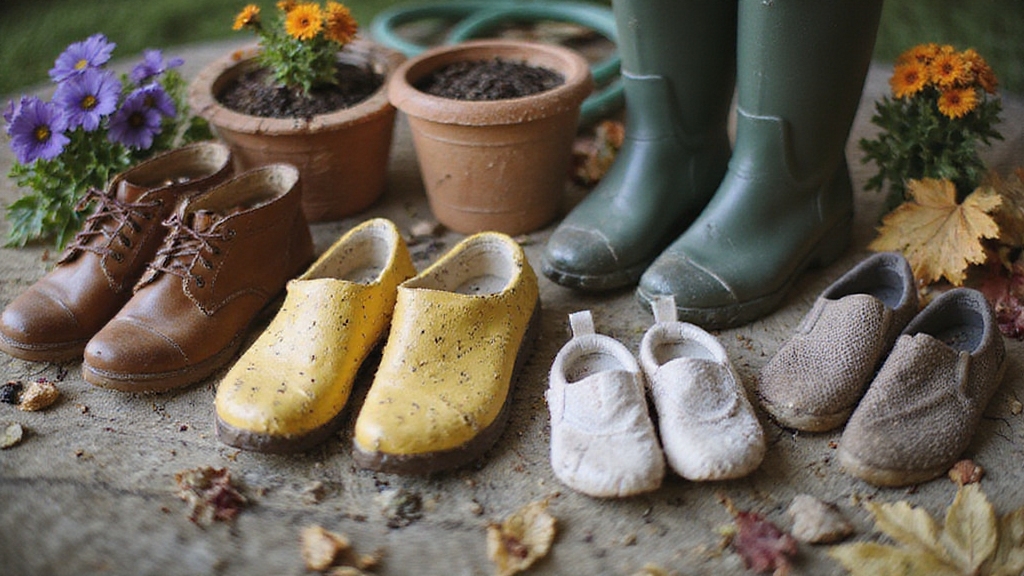
Choosing the right materials for your gardening shoes can make the difference between a comfortable day in the garden and sore, wet feet that cut your outdoor time short. You’ll find three main material categories, each with distinct advantages.
Rubber stands as the gold standard for gardening footwear. It provides natural water repellency, keeping your feet dry while preventing blisters. Rubber adapts to your foot shape, offers excellent durability, and requires only simple rinses for cleaning. This material delivers excellent support during extended periods of garden work. The Feverfew Garden Company Gloves in the best gardening gloves list offer similar benefits with their lightweight versatility and comfortable fit.
Synthetic polymers like EVA (ethylene-vinyl acetate) deliver lightweight comfort with waterproof protection. These materials resist chemicals, provide cushioning, and offer better breathability than rubber during warmer conditions.
Leather works best for light gardening tasks, providing arch support and breathability, though it requires special treatment for wet conditions.
Choosing the Right Shoe Type for Your Garden Tasks
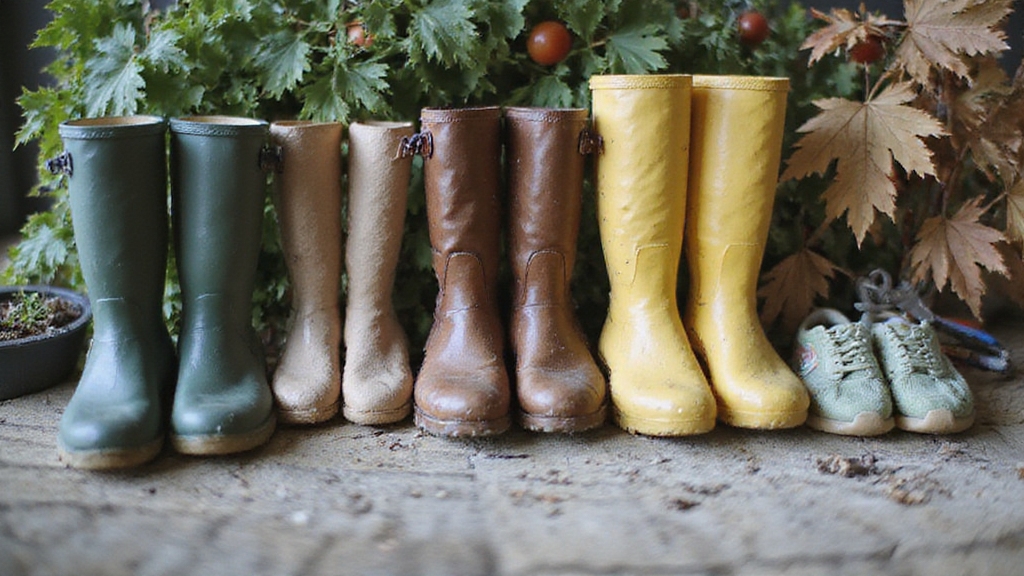
Success in your garden depends heavily on matching your footwear to the specific tasks you’ll tackle throughout the day.
Heavy-Duty Tasks
Steel-reinforced boots with thick soles and arch support are essential for demanding garden work like digging and soil preparation.
For digging, mulching, and soil preparation, you’ll need sturdy boots with reinforced construction. Steel shanks provide essential arch support, while thick soles protect your feet from sharp objects. Bogs Patch Ankle Garden Boots are an excellent choice for heavy-duty tasks due to their high durability scores and cushioned insoles.
Light Maintenance Work
Weeding, pruning, and harvesting require breathable, flexible shoes that won’t weigh you down. Convertible designs work well here, offering quick slip-on convenience.
Weather-Specific Considerations
Waterproof boots become essential during rainy conditions, preventing moisture from reaching your feet. In contrast, mesh panels and breathable materials keep you comfortable during hot summer tasks. Quality garden shoes with proper waterproofing are tested to perform in sub-freezing temperatures, ensuring year-round reliability.
Multi-Task Days
Choose versatile options with adjustable features when you’ll switch between different activities. Look for shoes with sturdy lug soles that provide stability across various terrain types.
Spring Gardening Footwear for Moderate Weather Conditions
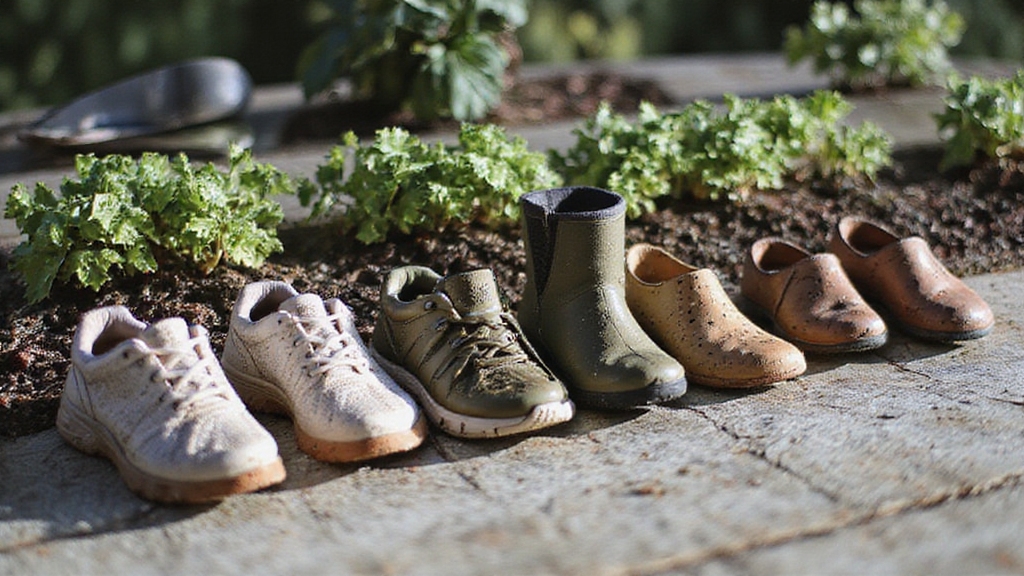
When spring arrives with its unpredictable mix of sunshine and showers, your footwear choices become crucial for comfortable gardening sessions. You’ll want ankle boots that balance water protection with mobility, allowing you to move freely between garden beds. Look for rubber construction or oiled leather materials that resist moisture while maintaining breathability. Consider selecting shoes that offer touch screen compatibility in case you need to operate devices without removing your footwear.
Choose shoes with cushioned insoles and flexible soles to handle varied terrain comfortably. Algae-based EVA footbeds provide excellent support during extended planting sessions.
For quick tasks, lightweight garden shoes offer breathability in mild temperatures, while high rubber boots protect against mud splashes during heavier work. These boots excel in activities like flower bed building, picking, and digging where ground contact is frequent.
Focus on proper fit with slight room for movement, accommodating thicker socks on cooler days. Easy on/off features like tabs enhance convenience when shifting between indoor and outdoor tasks.
Summer Shoe Selection to Beat the Heat
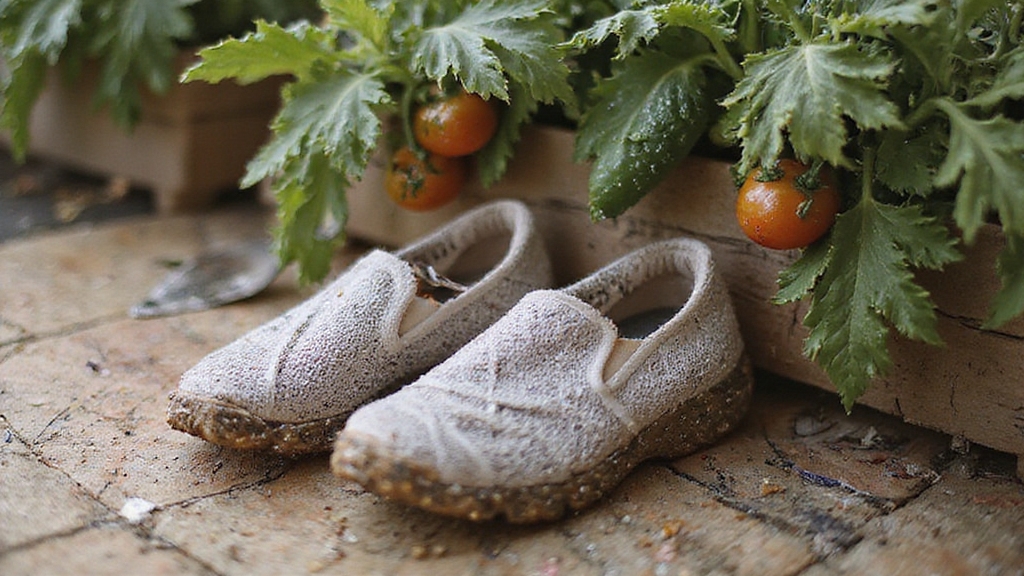
As summer temperatures soar, your feet need footwear that prioritizes breathability and lightweight construction over heavy protection.
Choose Ventilated Materials
Select clogs and lightweight garden shoes with breathable mesh components, moisture-wicking linings, and temperature-regulating materials. These features promote airflow, absorb sweat, and keep your feet cool during extended gardening sessions. If you’re in search of durability and ease, consider shoe materials that are known for standing up to repeated use and maintaining their breathable properties over time.
Breathable mesh and moisture-wicking materials ensure optimal airflow and sweat absorption for comfortable summer gardening sessions.
Prioritize Protection with Cooling
Rubber clogs offer excellent protection from dirt, insects, and thorny plants while allowing your feet to breathe. Look for boots with ventilated designs that protect your ankles without causing excessive sweating.
Focus on Comfort Features
Choose shoes with cushioned insoles, memory foam, or EVA footbeds for all-day support. Flexible materials facilitate natural foot movement during digging and planting activities. Quality gardening shoes with slip-resistant outsoles help prevent dangerous falls on wet garden surfaces.
Select Easy-Clean Options
Pick dirt-resistant surfaces and machine-washable designs with quick-dry technologies for effortless maintenance between garden sessions.
Fall and Winter Protection Against Cold and Moisture
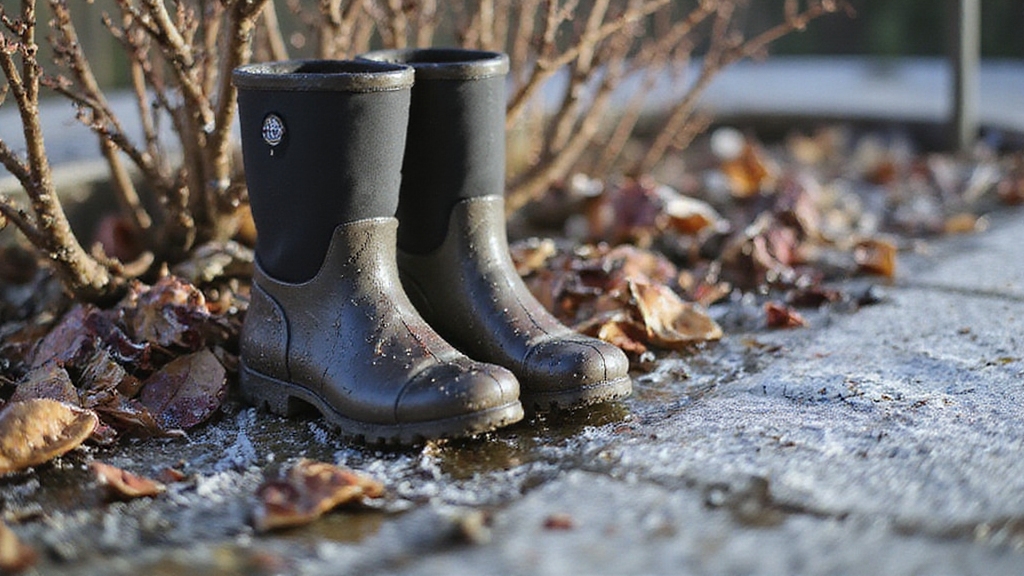
Cold weather gardening demands footwear that shields your feet from freezing temperatures, wet conditions, and muddy terrain that define fall and winter seasons. You’ll need waterproof materials like rubber and molded resins to keep moisture out, while insulated linings maintain warmth in subzero conditions. Look for boots with sealed seams, breathable waterproof membranes, and slip-resistant outsoles that grip wet surfaces safely. For those interested in long-lasting and kink-free features found in garden hoses, consider exploring similarly constructed insulated boots for optimal durability and performance.
| Feature | Benefit | Temperature Rating |
|---|---|---|
| Waterproof rubber uppers | Complete moisture protection | All conditions |
| Insulated fleece linings | Warmth retention | -40°F/-40°C |
| Memory foam footbeds | Comfort and heat insulation | Moderate temps |
| Slip-resistant soles | Safety on muddy terrain | All weather |
| Higher shaft design | Ankle protection from elements | Cold/wet seasons |
Choose slip-on designs with heel kicks for easy removal without touching mud. Look for cushioned insoles and breathable designs that provide all-day comfort during extended outdoor work sessions.
Comfort Features That Keep Your Feet Happy All Day
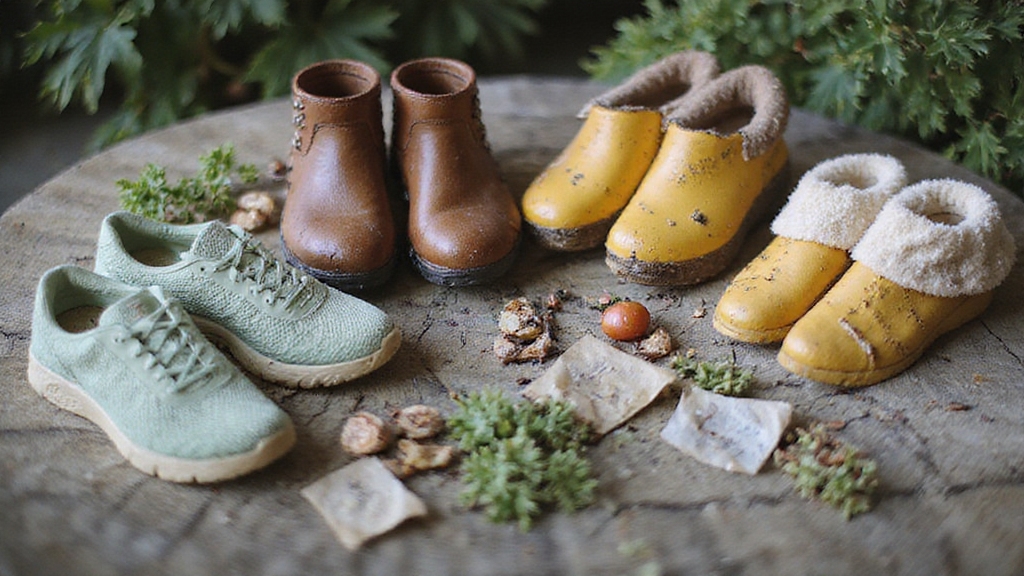
Since gardening often requires hours of standing, kneeling, and walking across uneven terrain, your footwear’s comfort features directly impact how much you can accomplish and how good you’ll feel at day’s end.
Memory Foam and Cushioning
Memory foam insoles conform to your foot shape, providing superior shock absorption that reduces fatigue during long sessions. Look for removable, cushioned insoles that you can clean or replace as needed. Some gardeners find that biochar aids in water retention for plants, contributing to healthier garden environments.
Lightweight, Flexible Design
Choose shoes made from lightweight materials that won’t strain your feet. Flexible soles adapt to uneven ground while supporting natural foot movement, preventing pain and enhancing stability.
Breathable Construction
Mesh outer shells and fabric linings promote airflow, keeping your feet cool and dry. This ventilation prevents overheating, reduces blister risk, and maintains comfort during warm-weather gardening tasks. Modern manufacturers are increasingly incorporating ergonomic features into their designs to enhance overall foot comfort and reduce strain during extended gardening sessions.
Performance Elements for Better Garden Navigation
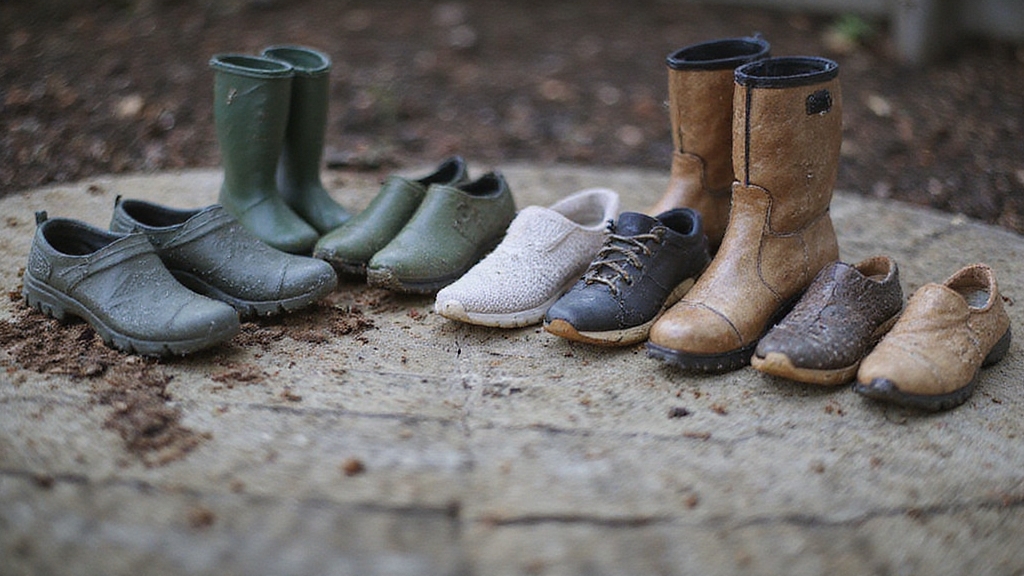
Three critical performance elements separate ordinary shoes from true gardening footwear: superior traction, reliable water protection, and sturdy construction that handles outdoor challenges. Your shoes’ outsoles need deep tread patterns and slip-resistant rubber compounds to grip wet grass, muddy paths, and loose soil safely. Waterproof membranes and seamless upper designs keep your feet dry during watering tasks, morning dew exposure, and rainy conditions. Reinforced toe caps, ankle support, and shock-absorbing features protect against falling tools, sharp objects, and uneven terrain impacts. Advanced gardening tools, like the Kent and Stowe Capability Trowel, often complement gardening routines that require stable footing and endurance.
| Terrain Type | Required Traction | Protection Level |
|---|---|---|
| Wet grass | Deep treads | Medium |
| Muddy paths | Slip-resistant soles | High |
| Rocky surfaces | Shock absorption | High |
| Loose soil | Flexible grip | Medium |
| Garden slopes | Maximum stability | High |
These performance features work together, ensuring confident navigation through diverse gardening environments. Quality materials like rubber, PVC, or EVA offer superior resistance to water and abrasion while simplifying cleaning after muddy gardening sessions.
Extending the Life of Your Gardening Shoes
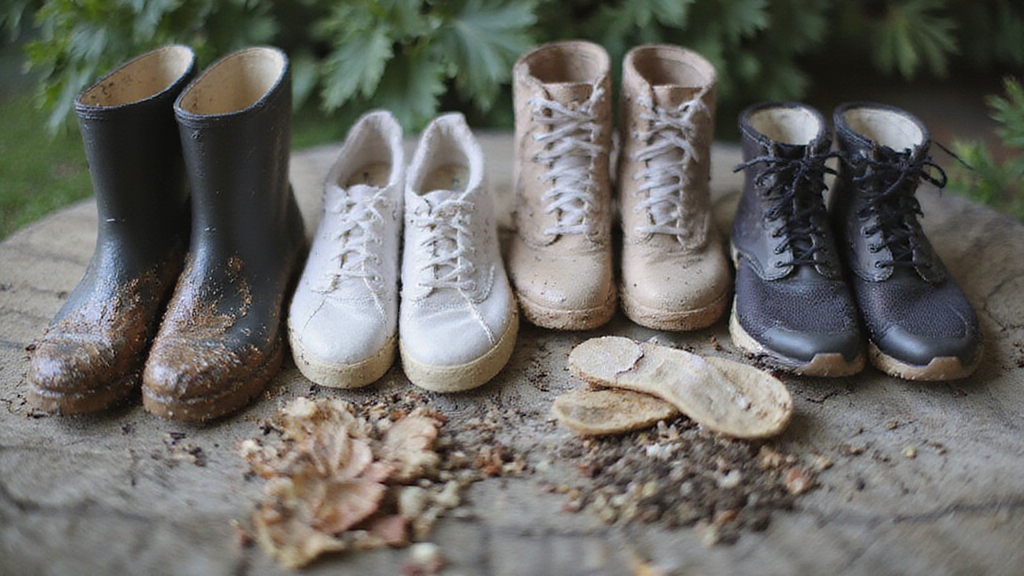
While investing in quality gardening shoes provides the foundation for comfortable outdoor work, proper maintenance guarantees they’ll serve you reliably for years to come.
Quality gardening shoes are only as good as the care you give them to ensure lasting performance.
Daily Cleaning Routine
Rinse your shoes with clean water after each use, removing soil and debris immediately. Use a soft brush for stubborn dirt in treads, avoiding damage to materials. Consider using compost bins, like the Green Johanna 330 Litre Hot Composter, to manage the garden waste you clean off your shoes.
Proper Drying Methods
Dry shoes in well-ventilated, shaded areas at room temperature. Stuff with crumpled newspaper to absorb moisture and maintain shape. Never expose them to direct heat sources like radiators.
Material Protection
Apply rubber care products periodically to maintain elasticity. Reapply waterproofing treatments annually, especially after deep cleaning sessions. Insert shoe trees during storage periods to prevent unwanted creases and deformations.
Regular Inspections
Check soles for excessive wear, monitor stitching for damage, and address minor scuffs promptly with appropriate conditioners.
Top-Rated Gardening Shoes Tested by Experts
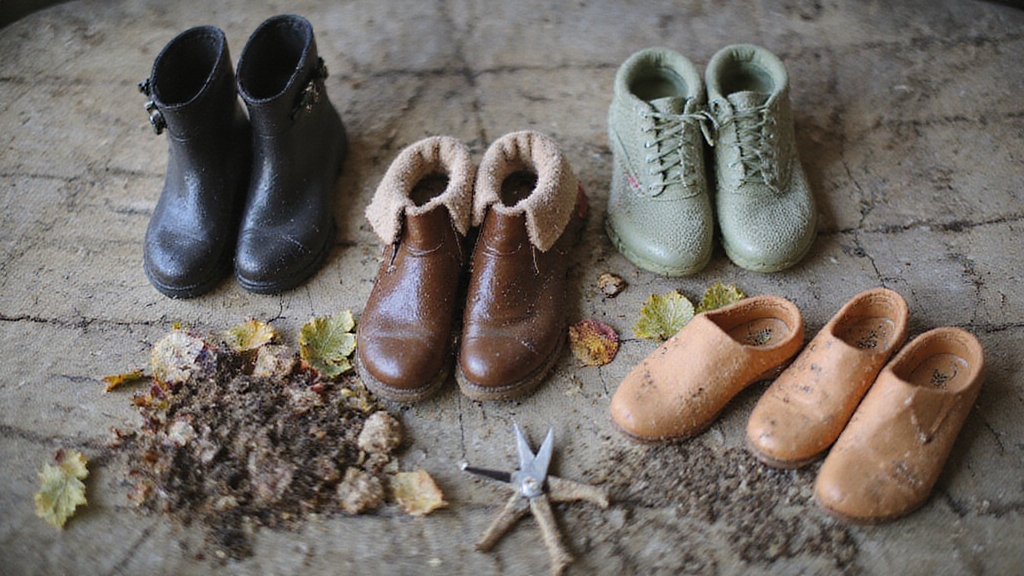
Professional gardeners and testing experts have put dozens of gardening shoes through rigorous evaluations, examining everything from waterproof performance to long-term durability. You’ll find these top-rated options consistently deliver reliable protection for your feet during various gardening tasks.
Expert testing reveals these standout features in top-performing gardening shoes:
- Waterproof materials like natural rubber and vulcanized construction that withstand puddles, mud, and garden hose exposure
- Breathable designs with ventilation holes and mesh linings that prevent moisture buildup during extended wear
- Slip-resistant outsoles that provide safety on wet terrain while remaining easy to clean after muddy work
Remarkably, these shoes pair perfectly with tools from Kent and Stowe and other high-quality brands, ensuring a seamless gardening experience. Testing criteria included comfort during long use, arch support for fatigue reduction, and overall value. The comprehensive evaluation involved testing 15 pairs in real garden environments over a six-month period to assess how each shoe performed under authentic conditions. You can trust these expert-tested recommendations to handle multiple seasons and diverse gardening conditions effectively.
Frequently Asked Questions
Can I Wear Gardening Shoes Indoors Without Damaging Floors?
You can wear gardening shoes indoors, but you’ll risk damaging floors without proper precautions. Clean your soles thoroughly before entering, removing dirt and debris that scratch surfaces.
Use entry mats to protect flooring, and choose shoes with soft, non-marking soles. Hard or aggressive treads damage wood and tile. Consider switching to indoor shoes after gardening to prevent floor scratches, stains, and finish degradation.
How Do I Determine the Right Size for Waterproof Gardening Boots?
You’ll need to measure both feet while standing, using the larger measurement for sizing. Measure from heel to longest toe, then check the widest part across your foot’s ball. Leave 1-1.5 cm extra space for thick socks and natural movement.
Always consult each brand’s specific sizing chart since measurements vary between manufacturers, and consider sizing up for thicker-soled boots.
Are Expensive Gardening Shoes Worth the Investment Over Budget Options?
Expensive gardening shoes typically offer better value long-term. You’ll get superior durability, waterproofing, and comfort that lasts multiple seasons.
While budget options work for occasional use, they wear out faster and lack proper support. If you garden frequently or work in wet conditions, invest in quality shoes. They’ll save you money over time, reduce foot fatigue, and provide reliable protection when you need it most.
Can Gardening Shoes Be Worn for Other Outdoor Activities Like Hiking?
You can definitely wear certain gardening shoes for hiking, especially ankle boots with waterproof materials and sturdy soles. Look for designs that offer good ankle support, cushioned footbeds, and durable construction.
However, avoid gardening clogs for intense activities since they lack proper support and may slip off during vigorous movement. Choose lightweight, breathable options with strong grip for the best versatility across outdoor activities.
What’s the Best Way to Break in New Gardening Boots?
Start by applying leather conditioner to soften stiff areas before wearing your new boots. Wear them for short periods initially, gradually increasing duration each day.
Use wool or synthetic socks to prevent blisters, avoiding cotton materials. You can gently warm boots with a hairdryer before wearing to increase flexibility.
Apply conditioner regularly during break-in to maintain leather softness and prevent cracking.
Conclusion
You’ve learned how to select gardening shoes that’ll protect your feet while you work. Remember to match your footwear to the season, weather conditions, and specific garden tasks you’re tackling. Quality materials, proper fit, and regular maintenance will keep your shoes performing well year after year. Choose comfort features that support long gardening sessions, and don’t forget to clean your shoes after each use to extend their lifespan vastly.

